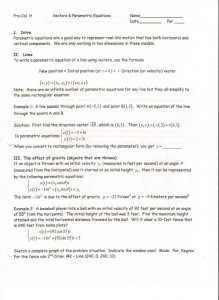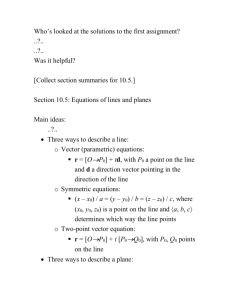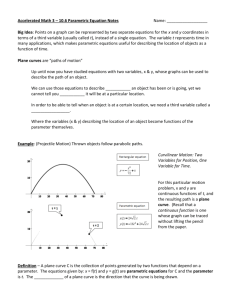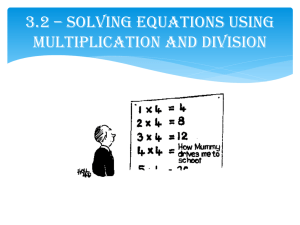Parametric Equations
advertisement
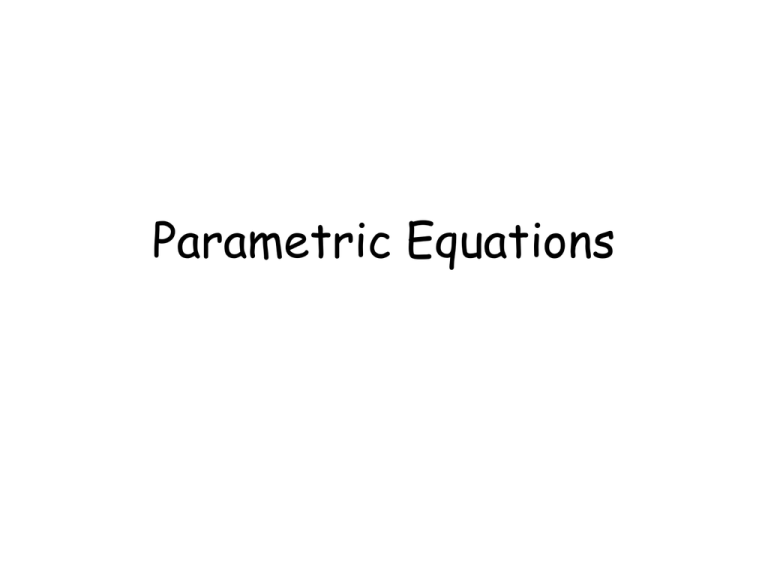
Parametric Equations Two ships, the Andor and the Helsinki, are sailing in the fog. The same tracking equipment is monitoring both ships. As the ships enter the area being monitored, their positions are displayed on the observer’s rectangular screen by a brightened point. The point representing the Andor is at a point 900 mm from the bottom left corner of the screen along the lower edge of the screen. The point representing the Helsinki is located 100mm directly above the lower left hand corner. One minute later the positions have changed. The Andor has moved to a location on the screen that is 3 mm west and 2 mm north of its previous location. The Helsinki has moved to a position 4 mm east and 1 mm north of where it had been. Assume that the two ships will continue to sail at a constant speed on their respective linear paths. On the grid below, you will see the points representing the position of the two ships as the first appear on the tracking screen. On this grid, label each point with an H for Helsinki or an A for Andor and sketch the linear paths of each ship. Then, state whether the two ships, if they continue on their respective paths, will collide(crash). Defend your answer mathematically. Graph the parametric equations. Show algebraically that the parametric equations for the Andor are equivalent to the linear function that you found. Explain what the coefficient of the variables and the constant mean in the function x(t) = at + b, y(t) = ct + d and how they relate to the linear function y(x). Your Turn Plane A is spotted on a rectangular tracking screen, by an air traffic controller at (420,0) flying west 2 miles and north 3.2 miles each minute. 1. Write a linear equation to represent the path of the plane. 2. What is the speed of the plane? (Be sure to include units) 3. Write the parametric equations that model the location of the plane, t minutes after it has entered the screen. Plane B enters the screen and its path is given by the parametric equations x = t and y = 300 + 1.5t. The planes are flying at the same altitude. 4. Find the point at which the paths of plane A and plane B intersect. 5. Find the amount of time it takes Plane A and Plane B to get to the point of intersection. Do the planes crash? Sketching a graph Sketch the curve represented by the parametric equations (indicate the direction using arrows) for -3 < t < 3. 2 x t 3 y 2t Eliminate the parameter and write the corresponding rectangular equation whose graph represents the curve. Parametric Equations Investigation Along the River Thames in London, England, there is a huge Ferris wheel known as The British Airways London Eye, but often called the Millennium Ferris Wheel. The Wheel is 135 m (just under 450 ft) high and makes one complete revolution every 15 minutes, in a counterclockwise direction, when the ride is underway. For this exploration, we will reduce the immense passenger capsules to mere points on the rim of a circular wheel. The capsules must clear the ground in their rotation, but we will assume that the radius of the Wheel is the full 67.5 m — exactly one-half the height of the Wheel. This will allow our model to reflect ground level access to the capsule for its passengers. Recall the radius of the London Eye Ferris wheel was 67.5 meters. Write parametric equations to represent a circle with radius 67.5 meters. Also recall that the wheel revolves once every 15 minutes. How far will the wheel rotate in 1 minute? This is the angular velocity and is the coefficient of t in our parametric equations. 3) Let the point (0, 0) correspond to the location of a capsule when it is at ground level and let t = 0 represent the time when a particular capsule is at ground level. Write parametric equations that represent the motion of this capsule on the London Eye over the course of a 15 minute ride. Graph the equations on your calculator in an appropriate viewing window. What are the coordinates of the capsule at the beginning and end of the ride? How high off the ground is the capsule after 10 minutes?

